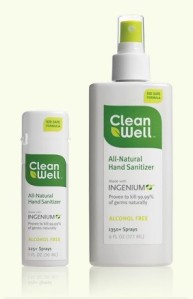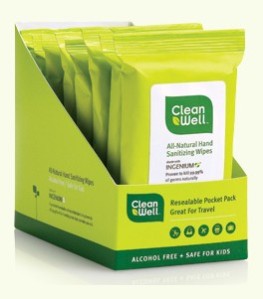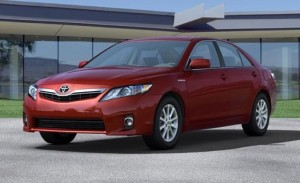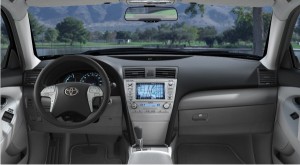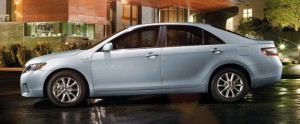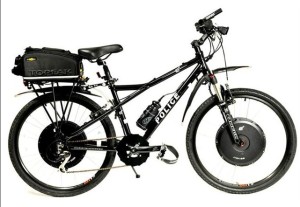
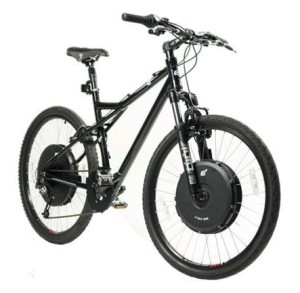 |
| The powerful, rugged E+ Elite Mountain Bike (photo via Electric Motion Systems website) |
Like a little raw speed with your electric bike?
I clocked my tester E+ Elite Mountain Bike from Electric Motion Systems at around 25 miles per hour on a flat straightaway with no pedaling.
The Elite version of the E+ bikes (designed for 'off road use only') comes with a 1000 watt in-wheel motor, but you can get 750 watt motor versions of the E+ bike in Cruiser or Mountain Bike styles that don't have the 'off-road only' stipulation.
The power of the in-wheel NiMH battery and motor system is definitely one of the major selling points for an E+ bike. Mounting the battery and motor low on the bike is also supposed to help keep the bike stable by creating a low center of gravity. The logic is flawless, but in practice it didn't make the bike feel appreciably more stable than any other e-bike that I've ridden.
So here's what I liked about the E+ Elite bike that I tested -
 |
| The in-wheel battery and motor design gives E+ bikes a distinctive silhouette (photo via Electric Motion Systems website) |
1. Speed and Power - Press down on the throttle lever and the bike takes off. It's like a stealth moped.
2. Rugged design - The bike felt fully capable of handling some light off-road action. The bike's manual indicates that the E+ Elite Mountain Bike can handle paved roads, gravel surfaces and even rough trails with small obstacles, but it does emphasize that the bike should not be used in a jumping scenario. Although it would have been nice if the E+ Mountain Bike came with some splash/mud guards - especially since the bike is designed to allow light off-road use where there's usually a lot of dirt, mud, gravel and other earthy stuff.
3. Made in the U.S.A. - Electric Motion Systems is based in Virginia, and that's where it makes its E+ bikes. I like the idea of supporting domestic production, both in the interests of reducing environmental shipping costs and supporting American workers (particularly in a recession).
4. Style - The E+ Elite Mountain Bike got admiring looks and comments from bike messengers, European tourists and others. It's not flashy, but it will get noticed.
5. Cruise Control - I don't think I've seen this feature on any other e-bike. Press a button on the E+QUE Display/Controller unit on the handlebar and the bike will attempt to maintain a set speed. It's pretty nifty.
6. Regenerative Mode - Like the OHM bike, the E+ bikes can be set into regenerative mode to recharge the battery while going down a hill (or perhaps when the bike is mounted into a stationary rack). Unfortunately, it seemed harder to use the E+ regenerative system than the OHM system. Even on a downhill slope, I had a hard time pedaling the E+ bike in regenerative mode.
Now here are the things that irked me about the E+ Elite Mountain Bike:
1. Price - Even though I didn't pay to test the bike thanks to the generosity of Electric Motion Systems and Scott Gibson of EcoPioneer, I can't test a product without considering its price (and therefore its value). After all, Tesla Motors may make a beautiful electric sports car, but the price puts it out of reach for most consumers.
The E+ Elite Mountain Bike carries a MSRP of approximately $4,000. For perspective, consider that a new Vespa LX50 scooter for MSRP $3,299. True, the Vespa uses gasoline and is therefore less eco friendly, but it does get 95-100 mpg and goes 39 mph (according to the Vespa site).
I'm just saying that I think it will be hard for most people who aren't rolling in dough to spend $4,000 on an electric bike when they could get a gas scooter for hundreds of dollars less (actually thousands of dollars less if they are willing to get a Yamah C3 or Honda Ruckus scooter).
Now Electric Motion Systems is running a limited time offer to give customers a free Elite upgrade plus a rebate. These deals bring the price of the bike down to a more palatable $3,095 with free shipping.
That's better, but it's still a lot of dough and a few hundred dollars more than some other e-bikes we tested like the OHM Urban XU500 or the A2B Electric Two Wheeler (both of which retail for around $2800).
Push-Lever Throttle - The E+ Elite Mountain Bike uses a push-lever thumb throttle on the right handlebar. When you want the motor to kick in, you have to push down on the throttle. It sounds simple enough, but in practice I much preferred the twist throttle used on the A2B bike. As one of my commenters pointed out on the A2B review, it's actually quite safe to have a throttle that needs to be twisted toward you in order to generate power because it makes it much harder to accidentally gun the motor when reaching for the brake. But with a push-lever thumb throttle, I did just that and nearly accelerated into trouble a couple of times when I was trying to execute a sudden braking maneuver.
Weight - Like the A2B, the E+ Elite Mountain Bike tipped the scales around 70 lbs. Since mountain bikes already have more resistance than road bikes due to their thick tires, I found it nearly impossible to pedal the E+ Elite Mountain Bike without constantly using at least a little bit of battery power. I would urge Electric Motion Systems to prioritize weight reduction in their R&D effort, since a 10 or 20 pound lighter bike (like the OHM XU500 or the iZip Via Rapido) is much easier to pedal with pure human power - extending the range and providing the possibility of some exercise. (The combination of mountain bike seating and the need to constantly push the throttle with my thumb ended up putting a lot of pressure on the outside fingers of my right hand. In fact, after one long ride, my little finger and ring finger on the right hand were partially numb and tingly for hours. Not a good feeling.)
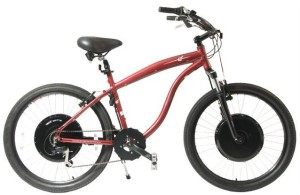 |
| Maybe you would prefer your E+ electric bike in a Beach Cruiser style? (photo via Electric Motion Systems website) |
Range - Electric Motion Systems says that the E+ Elite Mountain Bike should be able to go 25-28 miles on a full battery at 15 mph with a 185 lb. rider on flat ground and no pedaling. I weigh a good 25 lbs less than that theoretical rider and managed only around 15 miles of range with occasional pedaling on mostly flat terrain. For some of this time, I was experimenting with the Cruise Control feature of the bike (which I later found out might reduce range according to some online forums), but I still have to say that I was disappointed that the battery didn't last a longer distance.
Recharging Process - Not only did the recharging process take many hours, but the process of connecting the charger to the bike itself is a bit cumbersome. (In fact, I ever cut my hand a little bit trying to disconnect some wires in order to get access to the charging plug the first time I tried to recharge the bike. After that, I wore gloves when taking the charger on and off the bike.
Also, because the battery is built into the wheel, it's impossible to take the battery off the bike for recharging without removing the whole front wheel. In my opinion, that's a significant drawback to the E+ design. One of the nice things about the designs of many e-bikes - even much less expensive bikes like the iZip Via Rapido - is that it's easy to park the bike at a rack and remove the battery to take it into an apartment or office for charging. To be fair, taking the wheel off the E+ Elite Mountain Bike isn't that hard, but it is a heavier, more time-consuming, dirtier process than just sliding a battery pack out of the bike and literally putting it into a shoulder bag or bookbag.
Bottom Line - If you have deep pockets and are looking for a fast, rugged, made-in-the USA electric bike that can deliver some serious off-road fun, the E+ Elite Mountain Bike could be just the ticket. For urban commuters, I think there are some less expensive and more versatile options like the A2B (for twist-throttle fans) or the iZip Via Rapido (for those who prefer pedal-assist).
Where to Buy:
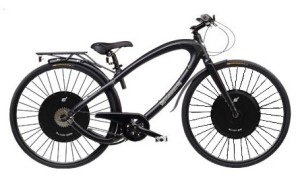 |
| The Ellsworth Commute Ride, just one of the sweet custom designs offered by E+ (photo via Electric Motion Systems website) |
You can order an E+ Elite Mountain Bike - or any of the other electric bikes that Electric Motion Systems makes - directly through the company's website.
Be sure to check out the sweet array of custom designed e-bikes that E+ can build on request.
Since every e-bike feels different, I'd highly encourage you to test ride an E+ bike at a local dealer in the U.S. or Canada before making a purchase decision.
Be sure to ride safely, wear a helmet and check the local regulations covering the use of e-bikes in your community.
Disclosure - E+ loaned me an Elite Mountain Bike to test and review for approximately one week. I returned the bike to an E+ representative at the end of the test period.
